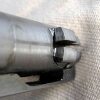frank de hass does not agree with you about post war 98 fn actions.
That is not the full and complete story. Just read the FN section in "Bolt Action Rifles". Frank relates a FN Deluxe rifle, probably rebarreled or rechambered by him, to 300 H&H Improved Magnum. This is one of the actions where the feed ramp was reduced to length the magazine. Frank claims these actions "should be safe for 50 K (CUP) cartridges", but this action cracked its lugs. (someone who spends the money for a 300 H&H Improved barrel, is probably running the pressures insanely hot) Frank attributes the lug cracking to set back in the receiver seats, which is good assumption, but he attributes the set back due to the feed ramp reduction. He does not know this to be true. He does not know the steels used in FN actions, merely states that
"you can be sure it is the best", and he sure as heck did not create a finite element model to look at lug stresses given the pressures and materials used. He does not know a reasonable fatigue lifetime given the loads on the bolt and receiver seats. Also, bolt thrust is internal pressures times cartridge case head diameter (worst case). The magnum bolt face is wider. I have had posters quibble whether bolt thrust is calculated based on ID or OD at maximum case head separation, but in a comparison of military Mausers, designed for a 43,000 psia 8mm, here are some bolt thrust numbers
From
Cartridges of the World
8 mm case head diameter 0.470” Area 0.1735 square inches
300 Win Mag case head diameter 0.515” Area 0.2083 square inches
Bolt face loads
8mm (Mauser design loads) 0.1735 in ² X 43, 371 lbs/ in ² = 7, 525 lbs
300 Win Mag = 0.2083 in ² X 65,000 lbs/ in ² = 13, 539 lbs
The 300 Win Mag provides an 80% increase in bolt thrust over standard military loads. You can play with the numbers for a 270 Win if you want. And that is if the reloader is not creating 80,000 to 90,000 psia reloads! I am going to claim, the sort of person who wants a belted magnum cartridge, is exactly the sort of person who pours on the coal, and if the rifle does not blow up within ten shots, thinks his reloads are safe!
Now one thing I would like to know, what were the pressures of the original H&H Magnum cartridges as assembled by H&H England and used in pre WW2 Mauser actions?. The cartridges were proprietary to H&H in England. Based on an article in a gun magazine, period H&H catalogs are quoting velocities maybe 100 fps more than a 30-06. I don't remember the exact numbers, but they were below, by a good margin the velocities once Winchester had the round approved in the USA, back in the 1920's? But the pre 64 M70 was always sized for H&H length cartridges, and I am going to claim, sized for the American standards set by Winchester for their 300 H&H and 375 H&H. And the M70 was made in 4140 steel, a much higher grade of steel than the 1035 (Hatcher) used in German Mausers. So if anyone has those pre WW2 proprietary H&H pressure standards, please put them out there.
To stir the pot more, Frank's book was copy righted in 1971, so he was writing the thing around 1965 onwards, a guess. The book had to be compete about a year before publication. So most of the FN Deluxe rifles on the market were around 10 to 15 years old, and FN probably had spare parts. Not now! Lets say the early FN Deluxe's are 70 years old, just how much does a magnum bolt cost? And who has them? About 25 years ago I purchased from Jack First a "FN commercial bolt" with a standard bolt face. I was disappointed it was an FN Supreme bolt, not FN Deluxe. The Supreme had a trigger blocking safety. I kept the bolt though I paid about $200.00 for it. Supreme actions are going for under $500. Gunbroker has a
FN Deluxe bolt with a 30-06 bolt face for $337.50, (four days to go!) a bargain if it means, without that bolt, the rifle is a paperweight. I wonder what the Magnum bolt face version would go for, since they are rarer. There is no guarantee a replacement bolt, won't also require some other changes. We would love all repairs to be simple drop ins, and sometimes it happens. I saw on
Wheeler Dealers, the car repair show had to fabricate a custom gear, because originals were not around. It took a CAD/CAM model to design, and then writing the software for the CNC machine, and when the part was fabricated, it was not cheap. But without it, the car was a potted plant container.
I think anyone with a FN Deluxe action in a belted magnum, should be reloading his magnum cartridges at the low end of the spectrum. It will last longer.












